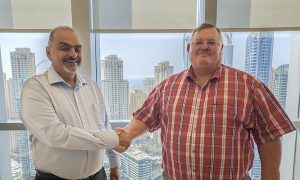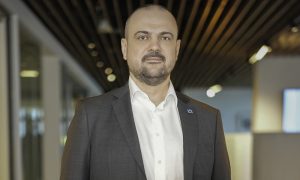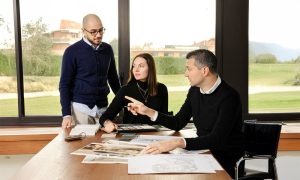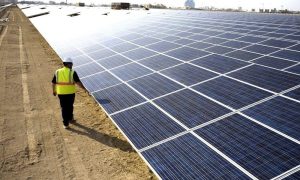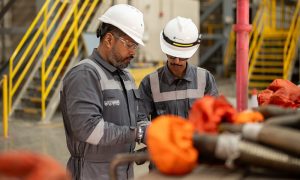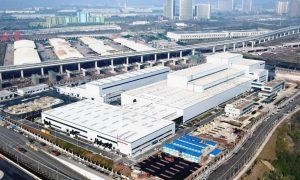Heavy hitters: ALEC execs on the GCC machinery market
Interview with ALEC’s Mark Oberholzer and Barry van Dyk

Progress is impossible without change. This sentiment is at the core of ALEC’s values, as Mark Oberholzer, PMV manager, and Barry van Dyk, Cranes and Equipment manager, discuss the continued reputation of ALEC and the strategy driving the company forward in an increasingly competitive construction sector.
A subsidiary of the Al Jaber Group, ALEC has evolved and grown since its inception in the UAE in 1999, focusing on the execution of major construction projects across the GCC. With operations in the UAE, Oman and Qatar and a total workforce of 9,700 employees, Oberholzer and van Dyk have embraced the importance of change, combined with an appreciation for experience and a focus on future trends.
“From my side, it’s all about specifics,” van Dyk begins, highlighting his role in managing the demands of various construction projects being carried out by ALEC. “First of all, you need to understand the particulars of the demands, and then focus on time. When does the client need the equipment and machinery on-site, and for how long do they need it?”
“You need to be an expert in planning too. You need the specifications, and then also because we have so many projects, you need to understand the priority and importance of each one compared to the others. Once you understand all of this, then you can prioritise and start putting measures in place to balance things out and to meet the demand.”
Building upon his opening comments about operational logistics, van Dyk leads the conversation towards the specific machinery technologies and processes which ALEC has introduced in recent months, pointing to the importance of continuously improving productivity, looking after equipment and embracing new ideas.
“Our fleet is state-of-the-art, it’s got technology that we feel works best for us. On top of that, updating crane technology these days is just like updating software on laptops and mobile phones. Whenever the manufacturers come out with upgrades, we adopt them; even with the mechanical and electrical side of things, we get them from the manufacturers and promptly install them on our cranes.”
Never becoming complacent in their operations is a foundation of their success. Oberholzer seizes this opportunity to discuss the growing future role that new technology will play in construction fleet management at ALEC.
“We are busy developing telematic technology now. Plans to install a dedicated telematic control room in our Jebel Ali headquarters are already underway. We will be fully capable of monitoring each and every machine individually, live on-site, thanks to large-scale monitors mounted on every wall of our control room. We’ll see detailed data from the different machines and manufacturers displayed live across numerous dedicated screens.”
The implications for such advances become clear, as Oberholzer continues to vividly discuss the benefits to machine uptime, repairs costs and project efficiency, all thanks to the active adoption of the latest technology.
“We are going to develop a full tracking system so we can monitor all the machines, vehicles and cars – everything. Our vision is to have a dedicated team of analysts operating the control room permanently – 24 hours a day – monitoring all the systems, on all of the machines, so we can analyse and proactively respond to every telematic sensor installed throughout our entire fleet.”
Oberholzer points out that new OEM machinery from 2014 has started coming with telematic technology as standard. For this reason, ALEC is responding to the new market developments and will be fully capable of meeting client expectations ahead of time.
“Additionally, we are developing a mobile application, so even operatives on the ground can monitor the fleet and respond to data, regardless of their location.”
Past success is no guarantee of a secure future, as Oberholzer and van Dyk discuss. The exponential growth of new technologies is certainly having an impact on the construction machinery sector, and there is an ever-present need to be innovative, actively identify new trends and stay ahead of the competition. To overcome the challenges presented by competitors, ALEC is focusing on embracing change and increasing the added value clients can expect from their operations.
This motivation to provide added value encompasses professional development opportunities for all members of their team too. With a compulsive drive to maintain safety standards throughout their operations, van Dyk takes this opportunity to slow the pace of the conversation and emphasise ALEC’s approach to best practice.
“Safety training is very important, but it shouldn’t be confused or substituted with technical knowledge and skill. At the end of the day, from a plant perspective, the safest people you can have are the best skilled people and the most knowledgeable.”
When asked about the importance of experience in the field, van Dyk offers a surprising perspective on the topic, specifying that it is not only safety training that makes people safe.
“It’s a combination of training, experience and knowledge – you have to study. We have thick manuals to read, two manuals for each crane, so you cannot escape the importance of continual learning.”
While governments in the region do have a role in providing regulations, it is generally up to consultants and contractors to create awareness, uphold safety standards on-site and ensure rules are being followed.
“Experience is crucial,” van Dyk continues. “Our people have been with us for a very long time, some of our team have actually been with us for eight to ten years plus.”
With multicultural staff employed by ALEC, language training is also provided in order to ensure instructions are understood by all. This level of training is ultimately concerned with productivity or minimising errors, as van Dyk continues, “We’ve also introduced processes for our operators, so we do annual refresher training and we bring them in for one week and go through the whole training refresher course with them, in addition to conducting a medical check-up.”
“We prefer to do most of our construction machinery training in-house, because we believe we can do it better than if we were to outsource it. From the start, we are involved in the planning stages right through to execution, because we have to make sure that the manufacturer’s specifications and recommendations are followed all the way through. We provide a 360-degree service to our projects, so we’re always there for the client.”
When it comes to revealing the secret of best practices at ALEC, van Dyk highlights with enthusiasm the processes he has put in place. Taking apart every piece of machinery, conducting inspections and quality checks before repairing and reassembling everything, is an element van Dyk discusses with gusto. “We refurbish the whole machine, everything, then we test it, and then we send it out to the project, so it’s already passed our strict tests, it works and it meets our very high standards.”
Their approach to servicing equipment holds this same level of consideration for standards and best practices. Oberholzer describes some of the most important factors in keeping construction machines operational. “We run quite a strict hourly-based maintenance system – all our machines get serviced every 250 hours, every single one, and it’s compulsory, we don’t take any short cuts. We also only use OEM parts, we’re not allowed to use other parts, so everything is original.”
Pressed for further insights into servicing, replacing and upgrading construction machinery, Oberholzer reveals that ALEC operates largely independently of machine suppliers. “We do all the work in house, everything – maintenance, services, the works. The only time we’ll go to them [suppliers] is when it’s a specialised repair that has to be done – I’d rather take it to the supplier because it’s more productive, they’ve got all the equipment to fix it efficiently and I’ll still get the warranty.”
Testament to the skills and attention to detail provided in-house at ALEC, Oberholzer notes that with regards to turnover cycles, “I’m running machines with 45,000 to 48,000 hours, and they still have the original engines and transmissions. But we are changing the system now, we will more than likely begin changing the machines and start selling them off and replacing them with new ones after six-seven years, depending upon the hours.”
A walk through the Jebel Ali plant reveals the manifestation of Oberholzer and van Dyk’s values in action. Dedicated and spacious work stations equipped for specific operations are manned by a busy workforce, labouring on a wide range of construction machinery and equipment. Purpose-built classrooms are stocked with tables, chairs, whiteboards and teaching materials, all in preparation for the latest HR and training developments. A rotation of construction equipment returning to the plant for assessment and newly-inspected machinery ready for the work-site can be seen in action. A tight ship is being operated by ALEC, and with the active adoption of changing technology, customer demands and market trends, progress looks set to continue in the future.
Upgrading Machinery
ALEC recently purchased the new JCB 540/200 20m Load-All for use in the Middle East. The longer reach offered on this model will help the elected sites become more productive.
As well as productivity gains, ALEC highlights that safety was integral to the decision to purchase their 25th JCB Load-all. The telehandler comes equipped with overload sensors, meaning the machine can’t be overloaded, significantly reducing the risk of a major accident.
Safety features such as the overload sensors on the telehandler advise operators when they’re working with too much material, greatly reducing the risk of the machine tipping.
The new machine also has a more resourceful working system which makes loading and offloading more efficient, and is the only rigid chassis 20m telehandler in the industry, purchased due to the additional range it offers.
The extra 3m over its predecessor enables operators to reach to an additional floor, while the chain-driven boom with simultaneous extension and retraction translates to huge productivity and efficiency benefits for one of the Middle East’s largest contractors.
The 20m Load-All will be used across multiple building projects in Abu Dhabi and Dubai. ALEC’s total JCB fleet now has 30 machines.




